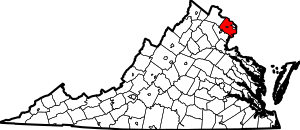Tysons, Virginia
Tysons, also known as Tysons Corner,[5] is a census-designated place (CDP) and unincorporated community in Fairfax County, Virginia, United States.[1] Located in Northern Virginia between the community of McLean and the town of Vienna along the Capital Beltway (I-495), it lies within the Washington Metropolitan Area.[6][7] Tysons is home to two super-regional shopping malls—Tysons Corner Center and Tysons Galleria—and the corporate headquarters of numerous companies such as Intelsat, DXC Technology, Gannett, Hilton Worldwide, Freddie Mac, Capital One, and Booz Allen Hamilton. Tysons is Fairfax County's central business district and a regional commercial center.[8] It has been characterized as a quintessential example of an edge city.[9] The population was 19,627 as of the 2010 census.[1]
Tysons, Virginia | |
|---|---|
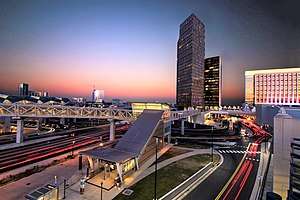 Skyline of Tysons from Tysons Corner Metro station at sunset | |
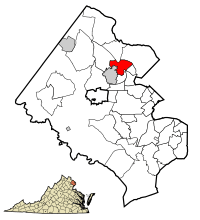 Location of Tysons in Fairfax County, Virginia | |
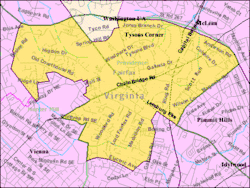 Boundaries of the Tysons Corner CDP as of 2003 | |
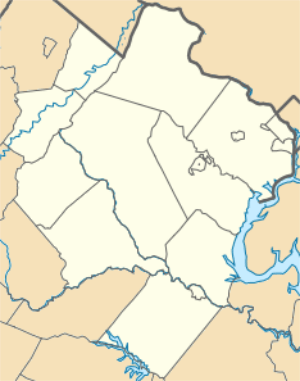 Tysons, Virginia Location of Tysons in Fairfax County, Virginia  Tysons, Virginia Tysons, Virginia (Virginia)  Tysons, Virginia Tysons, Virginia (the United States) | |
| Coordinates: 38°55′7″N 77°13′47″W | |
| Country | United States |
| State | Virginia |
| County | Fairfax |
| Area | |
| • Total | 4.27 sq mi (11.1 km2) |
| • Land | 4.26 sq mi (11.0 km2) |
| • Water | 0.01 sq mi (0.026 km2) |
| Elevation | 486 ft (148 m) |
| Population | |
| • Total | 19,627 |
| • Estimate (2018) | 23,749 |
| • Density | 4,600/sq mi (1,800/km2) |
| Time zone | UTC−5 (Eastern (EST)) |
| • Summer (DST) | UTC−4 (EDT) |
| FIPS code | 51-79952[3] |
| GNIS feature ID | 1496341[4] |
History
Known originally as Peach Grove, the area received the designation Tysons Crossroads after the Civil War.[10] William Tyson, a Maryland native from Cecil County, purchased a tract of land from A. Lawrence Foster.[11] Tyson served as postmaster of the now discontinued Peach Grove Post Office from 1854–1866. The Peach Grove Post Office was established on April 22, 1851.[12]
As recently as the 1950s, Tysons was a quiet rural intersection flanked by a few small stores, and a fruit stand operated by Mr. Tyson, who sold apples and apple cider from the corner of his property. Big changes came in 1963 when the Tysons area moved from a country crossroads to a giant commercial urban area with the awarding of contracts at the interchange of Route 7 and Route 123.
In 1962, the Fairfax County Board of Supervisors approved the Tysons Corner Shopping Center (now Tysons Corner Center), which was planned to be 88.13 acres (356,600 m2) within a 150 acres (0.61 km2) triangle bordered by Chain Bridge Road, Leesburg Pike, and the Capital Beltway. Developers proclaimed it as the largest enclosed mall in the world when it opened July 25, 1968.[13]
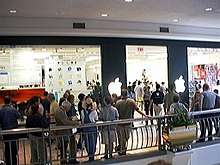
In recent years, the influx of technology companies into Northern Virginia has brought many new office buildings and hotels to the landscape. The rapid growth of Tysons (in comparison to other locations near the Capital Beltway) has been the topic of numerous studies.[14] One factor was the aggressive promotion of Tysons by Earle Williams, for many years the CEO of the defense contracting firm Braddock Dunn & McDonald.[14] Tysons serves as a "downtown" of Fairfax County, with one quarter of all office space and one eighth of all retail in the county. It is an auto-oriented edge city with severe traffic congestion, and it faces competition from the urban areas of Arlington and newer suburban edge cities such as Dulles.
In 2008, the Fairfax County Board of Supervisors unanimously voted to begin a 40-year plan to urbanize Tysons around the coming four stops of Washington Metro's Silver Line in the vein of neighboring Arlington County's Rosslyn-Ballston corridor.[15] A preliminary estimate from the Fairfax County Department of Transportation suggested that $7.83 billion in transportation infrastructure projects will be necessary to transform Tysons Corner into a high-density urban center from 2010 to 2050, most of which will be allocated to both construction phases of the Silver Line. Existing plans call for construction of a grid layout for streets around the rail stations, projected to cost $742 million. An additional $1 billion will be spent on further transit and street grid projects from 2030 to 2050.[16]
In November 2012, the county approved Arbor Row, a 2,500,000 ft (762,000 m) mixed-used development containing office and residential highrises, ground-floor retail, and underground parking near the Tysons Corner Station.[17] In April 2013, the county approved Scotts Run Station South, a 6,700,000 ft (2,042,160 m) development containing 17 buildings, including six office and residential buildings, one hotel, and ground-floor retail near the McLean Station. This development alone will be larger than Reston Town Center.[18][19]
Ahead of the Washington Metro Silver Line opening in mid-2014, the Fairfax County Board of Supervisors and the Tysons Partnership, a nonprofit association that represents the area's stakeholders, began rebranding the area as simply "Tysons", dropping "Corner" from the name. The change started as a matter of convenience, but later took hold to market the change in the area's character, according to members of the board. The change was unofficial at the time, and either "Tysons" or "Tysons Corner" could be used in addresses.[5] However, in November 2015, the U.S. Census Bureau announced the CDP's name would officially be changed to Tysons effective the following summer.[20]
Current developments
Tysons is seen as a modern prototype of an edge city. Tysons in its brief 40-year history has been given substantial redevelopment offers for the next 20 to 30 years.[21] This particular area has seen a growing amount of interest as plans to make it an urban center were already begun in 2010. Private-sector development within the United States in combination with political groups have begun the planning process behind the redevelopment of Tysons.[22] There are two forces at work in the creation of an edge city as it can be beneficial to both parties. With the redevelopment process taking place there has been an aggressive push to bring in businesses to Tysons. Edge cities such as Tysons have specific regional accessibility that has been enhanced by major projects funded by federal and state governments.[22] One of the bigger enhancements to transportation specifically to Tysons was the construction “…of the Washington Dulles International Airport and an associated access road and the Capital Beltway but also expansions to state roads”.[23] Location and transportation is important to the creation of edge cities, this city is an example of investments placed on the surrounding area.
As for the future of Tysons, the plan remains to see the city become the downtown core of Fairfax County.[24] There is a clear purpose to the investments and the future when investing into edge cities. To this point “…eight districts have been delimited, with four centered on new metro stations being transit-oriented development districts”.[24] Future plans to transportation around the area continue to be made, the accessibility of the area is on the rise with many forms of transportation being formed. “The aims of the plan are for 75% of development to be within half a mile of metro stations, an urban center of 200,000 jobs and 100,000 residents, a jobs balance of 4.0 per household”.[24] Many of these plans have been created in order to create a fully metropolitan city from a small town. The small edge cities progressively become larger with the creation of distinct plans. For many individuals the interest with edge cities lies in what they can show about new trends across city regions. Tysons is a prime example of the future of edge cities and what other small towns all around the world could become.
Geography
Tysons is located at 38°55′7″N 77°13′47″W (38.918485, −77.229833) at an elevation of 486 feet (148 m).[4][25] Located in Northern Virginia at the intersection of Virginia State Route 123 and State Route 7, Tysons is 11 miles (18 km) west of downtown Washington, D.C. and 6 miles (9.7 km) northeast of Fairfax, the county seat.[26]
The community lies in the Piedmont upland approximately 3.7 miles (6.0 km) south-southwest of the Potomac River.[6][27] The highest natural point in Fairfax County, at 520 feet (160 m) above sea level, is located in Tysons.[28] Wolftrap Creek, a tributary of nearby Difficult Run, forms the northwestern border of the community. Two of the creek's tributaries, Moomac Creek and the Old Courthouse Spring Branch, flow north through northwest Tysons. Scott Run, a tributary of the Potomac, flows north through eastern Tysons.[6]
According to the United States Census Bureau, the community has a total area of 4.27 square miles (11.1 km2) of which 4.26 square miles (11.0 km2) is land and 0.01 square miles (0.026 km2) is water.[7]
As a suburb of Washington, D.C., Tysons is a part of both the Washington Metropolitan Area and the larger Baltimore-Washington Metropolitan Area. It is bordered on all sides by other Washington suburbs, including: McLean to the north, Pimmit Hills to the east, Idylwood to the southeast, Dunn Loring to the south, Vienna to the southwest, and Wolf Trap to the west.[7]
Climate
The climate in this area is characterized by hot, humid summers and generally mild to cool winters. According to the Köppen Climate Classification system, Tysons has a humid subtropical climate, abbreviated "Cfa" on climate maps.[29]
Demographics
| Historical population | |||
|---|---|---|---|
| Census | Pop. | %± | |
| 1980 | 10,065 | — | |
| 1990 | 13,124 | 30.4% | |
| 2000 | 18,540 | 41.3% | |
| 2010 | 19,627 | 5.9% | |
| Est. 2018 | 23,749 | 21.0% | |
| * U.S. Decennial Census 2018 5-Year Estimate[2] | |||
Tysons was one of the inspirations for, and figures prominently in, Joel Garreau's pioneering study of the edge city phenomenon.[9] Among the reasons for calling Tysons an edge city is that, in contrast to typical "bedroom" suburbs, people commute into it in the morning and away from it at night, with a daytime population greater than 100,000 and a nighttime population of fewer than 20,000.[30] Planners envision up to 200,000 jobs and 100,000 residents in coming decades.[15]
2010 census
As of the 2010 census, there were 19,627 people, 9,481 households, and 4,754 families residing in the community. The population density was 4,607.3 people per square mile (1,784.3/km²). There were 10,637 housing units at an average density of 2,496.9/sq mi (967.0/km²). The racial makeup of the community was 60.9% White, 27.5% Asian, 4.9% African American, 0.2% American Indian, 0.1% Pacific Islander, 1.9% from other races, and 4.5% from two or more races. Hispanics and Latinos of any race were 8.1% of the population.[1]
There were 9,481 households out of which 23.5% had children under the age of 18 living with them, 39.8% were married couples living together, 2.9% had a male householder with no wife present, 7.4% had a female householder with no husband present, and 49.9% were non-families. 40.7% of all households were made up of individuals, and 18.4% had someone living alone who was 65 years of age or older. The average household size was 2.07, and the average family size was 2.87.[1]
The age distribution of the community was 18.4% under the age of 18, 6.6% from 18 to 24, 40.4% from 25 to 44, 23.5% from 45 to 64, and 11.1% who were 65 years of age or older. The median age was 35.8 years. The gender makeup of the community was 47.7% male and 52.3% female.[1]
The median income for a household in the community was $94,083, and the median income for a family was $131,717. Males had a median income of $85,645 versus $66,019 for females. The community's per capita income was $64,294. About 2.8% of families and 4.2% of the population were below the poverty line, including 1.3% of those under age 18 and 14.3% of those age 65 or over.[1]
Economy
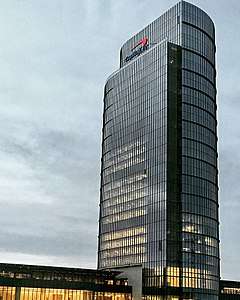
Tysons is Fairfax County's central business district with the largest concentration of office space in Northern Virginia.[8] Tysons had 46 million sq ft (4.3 million m²) of office and retail space as of 2008, making it the classic example of an edge city.[15] As of 2013, Tysons had 14 million sq ft (1.3 million m²) of office and retail space approved or under construction, approximately one-third of a 45 million sq ft backlog of projected urban development in close proximity to the area's four Metro Silver Line stations.[31]
The corporate headquarters of Appian Corporation,[32] Booz Allen Hamilton, MITRE Corporation, M.C. Dean, Inc., Capital One, Cvent, Freddie Mac, Gannett Company, Hilton Worldwide, Exelis, MicroStrategy, Octagon, Logistics Management Institute, Primus Telecom, SAIC, Space Adventures, Spacenet, Sunrise Senior Living, and USA Today are located in Tysons Corner, though most use a McLean or Vienna address.[33][34][35] The Fairfax County Economic Development Authority is also headquartered in the CDP.[8] Until 1996, AOL was headquartered in the Tysons CDP,[33][36] near the town of Vienna.[37] Qatar Airways operated its North American headquarters office in Tysons,[33][38] although it later moved to Washington, D.C.[39] Other firms with offices in Tysons include Adobe Systems,[40] BAE Systems,[41] Compuware,[42]DXC Technology, Palantir Technologies, Ernst & Young,[43] Northrop Grumman,[44] PricewaterhouseCoopers,[45] Xerox,[46] and Vie de France.[47]
The area is home to Tysons Corner Center – the largest shopping mall in the state and in the Baltimore-Washington area – and two upscale shopping centers, Tysons Galleria (also one of the largest malls in the region) and Fairfax Square, which neighbor it to the north and south respectively. The average household income within a 5-mile (8 km) radius of Tysons Corner Center is $174,809.[48] Every weekday, Tysons draws 55,000 shoppers from around the region.[49]
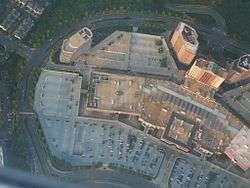
The CDP includes a technology industry base and network infrastructure. In 2007, roughly 1,200 technology companies were operating in Tysons. 31.6% of the jobs in the Tysons submarket and 20.2% of the companies in the submarket were in the technology sector.[8]
With 115,000 office and retail workers, Tysons is the 12th largest employment center in the United States.[50] As of 2012, 75.6% of the population over the age of 16 was in the labor force. 0.6% was in the armed forces, and 75.0% was in the civilian labor force with 70.4% employed and 4.5% unemployed. The occupational composition of the employed civilian labor force was: 66.4% in management, business, science, and arts; 20.3% in sales and office occupations; 10.5% in service occupations; 2.1% in natural resources, construction, and maintenance; 0.7% in production, transportation, and material moving. The three industries employing the largest percentages of the working civilian labor force were: professional, scientific, and management, and administrative and waste management services (28.8%); educational services, health care, and social assistance (13.3%); and public administration (12.8%).[1]
The cost of living in Tysons is very high; compared to a U.S. average of 100, the cost of living index for the community is 140.4.[51] As of 2012, the median home value in the community was $464,000, the median selected monthly owner cost was $2,649 for housing units with a mortgage and $906 for those without, and the median gross rent was $1,734.[1]
Government
As it is unincorporated, Tysons has no municipal government. The Fairfax County Government provides local government services directly.[52] For the purposes of representation on the Fairfax County Board of Supervisors, Tysons is located in the Board's Hunter Mill and Providence Districts.[53]
Companies in Tysons typically use McLean or Vienna addresses; however, in April 2011, the United States Postal Service approved the use of Tysons Corner as a postal address for the 22102 and 22182 ZIP codes of McLean and Vienna, respectively.[54]
Tysons lies within Virginia's 8th and 11th U.S. Congressional Districts. For the purposes of representation in the Virginia General Assembly, the community is located in the 32nd district of the Virginia Senate and the 34th and 35th districts of the Virginia House of Delegates.[55]
Education
Primary and secondary education
Fairfax County Public Schools (FCPS) provides public primary and secondary education to Tysons residents. Five FCPS schools are located in Tysons: Freedom Hill Elementary School, Joyce Kilmer Middle School, Westbriar Elementary School, Spring Hill Elementary School, and Westgate Elementary School.[56][57] Resident high school students attend nearby George C. Marshall High School, James Madison High School, Langley High School, or McLean High School.[56][58]
Libraries
Fairfax County Public Library operates the Tysons-Pimmit Regional Library in nearby Pimmit Hills.[59][60]
Transportation
Interstate 495, the Capital Beltway, runs generally north-south through eastern Tysons. Virginia State Route 267, the east-west Dulles Toll Road, runs along the community's northern border. The I-495/VA 267 interchange is located in the northeastern part of the community. Virginia State Route 7 runs southeast-northwest through Tysons, intersecting Virginia State Route 123, which runs northeast-southwest, in the community's center.[57]
Due to its large daytime population, Tysons experiences a high level of traffic congestion. This has led to plans for denser development, including additional rail infrastructure.[15] On July 26, 2014, the Washington Metro started offering rapid transit rail service in Tysons via its Silver Line.[61][62] Metro operates four stations on the line in Tysons; from east to west, these are: McLean, Tysons Corner, Greensboro, and Spring Hill. The Silver Line connects Tysons by rail with Reston to the west and Arlington, Washington, D.C., and Maryland to the east. Further extension of the line west to Washington Dulles International Airport is projected for completion in 2020.[63]
In February 2017, VDOT began construction on the Jones Branch Connector, a half-mile roadway that crosses Interstate 495 and connects Central and Tysons East, and is projected to carry more than 32,000 vehicles per day by 2040.[64]
References
- "U.S. Census website". United States Census Bureau. Retrieved 2011-07-23.
- "Tysons CDP, Virginia". United States Census Bureau. Retrieved 7 March 2020.
- "U.S. Census website". United States Census Bureau. Retrieved 2008-01-31.
- "US Board on Geographic Names". United States Geological Survey. 2007-10-25. Retrieved 2008-01-31.
- Reilly, Corinne; Victor Zapana (October 4, 2012). "Tysons Corner is unofficially dropping the 'corner' from its name". The Washington Post.
- "Fairfax County Transportation Plan" (PDF). Fairfax County Department of Transportation. Oct 2006. Archived from the original (PDF) on 2010-07-14. Retrieved 2011-07-23.
- "Virginia: 2010 – Population and Housing Counts" (PDF). United States Census Bureau. July 2012. Retrieved 2013-12-05.
- "Area Business Report." Fairfax County Economic Development Authority. Retrieved on May 12, 2009.
- Joel Garreau, Edge City: Life on the New Frontier, (New York: Random House 1992)
- "A look at the beginnings of Virginia's Tysons Corner". Washington Post. Retrieved 2018-07-20.
- "Why Is It Named Tysons Corner? - Ghosts of DC". ghostsofdc.org. Retrieved 2018-02-19.
- "Timeline of Fairfax County History - Fairfax County, Virginia". Retrieved 13 April 2017.
- Senese, Dr. Donald J. "Historians Tackled History of Tysons Corner". Great Falls Historical Society. Archived from the original on 2015-12-20.
- Ceruzzi, Paul E. (2008). Internet Alley: High technology in Tysons Corner, 1945–2005. Cambridge, Mass: MIT Press. ISBN 0-262-03374-7.
- "WTOP: Washington, DC's Top News, Traffic, and Weather". Retrieved 13 April 2017.
- Tysons will need $15 billion – 'with a B' The Washington Post
- "Arbor Row". Retrieved 13 April 2017.
- "Fairfax County board approves Scotts Run development in Tysons". Retrieved 13 April 2017.
- "Scotts Run Station". Retrieved 13 April 2017.
- Gilgore, Sara. "Tysons to officially drop 'Corner' from name in Census Bureau decision". WTOP.com.
- Phelps 2012, p. 671.
- Phelps 2012, p. 679.
- Phelps 2012, p. 679-680.
- Phelps 2012, p. 683.
- "US Gazetteer files: 2010, 2000, and 1990". United States Census Bureau. 2011-02-12. Retrieved 2011-04-23.
- "Virginia Official State Transportation Map – Cities in Detail". Virginia Department of Transportation. Retrieved 2011-07-23.
- "Piedmont province". The Geology of Virginia. The College of William & Mary Department of Geology. Archived from the original on 2011-08-07. Retrieved 2011-07-23.
- "Water Quality Factors" (PDF). Fairfax County Comprehensive Plan, 2011 edition. County of Fairfax, Virginia. p. 23. Retrieved 2011-07-23.
- "Tyson's Corner, Virginia Köppen Climate Classification (Weatherbase)". Retrieved 13 April 2017.
- "Estimated Daytime Population and Employment-Residence Ratios 2000". Retrieved 13 April 2017.
- Jonathan O'Connell. "Despite Silver Line delays, developers plot 45 million square feet of development in Tysons". The Washington Post.
- https://www.bizjournals.com/washington/news/2018/04/17/appian-to-move-hq-to-a-well-known-building-in.html
- "Tysons Corner CDP, Virginia Archived 2011-11-10 at the Wayback Machine." United States Census Bureau. Retrieved on May 7, 2009.
- "Contact Us Archived 2009-05-27 at the Wayback Machine." Spacenet. Retrieved on May 12, 2009.
- "Contact Us." Hilton Worldwide. Retrieved on October 14, 2009.
- "AMERICA ONLINE INC." The Washington Post. April 17, 2005. Retrieved on May 7, 2009.
- Sugawara, Sandra. "America Online to Reduce Rates; Firm Faces Subscriber Boycott, Pressure From Competitors." The Washington Post. October 13, 1994. Financial B09. Retrieved on May 7, 2009.
- "Washington." Qatar Airways. November 21, 2007. Retrieved on May 7, 2009.
- "Washington." Qatar Airways. Retrieved on May 7, 2009.
- "Adobe Systems, McLean, VA." Adobe Systems. Retrieved on Jun 5, 2017.
- "CS Information Technology, McLean, VA." BAE Systems. Retrieved on May 12, 2009.
- "Compuware Around the World Archived 2010-01-04 at the Wayback Machine." Compuware. Retrieved on January 7, 2010.
- "Our Locations." Ernst & Young. Retrieved on May 12, 2009.
- "Company Locations." Northrop Grumman. Retrieved on May 12, 2009.
- "Office locations in USA". PricewaterhouseCoopers. Retrieved July 30, 2016.
- "EFFECTIVE MARCH 4, 2009 WITH TEMPORARY PRICE REDUCTIONS PER MODIFICATION PO-0032" (PDF). Xerox Corporation. Archived from the original (PDF) on December 30, 2014. Retrieved July 30, 2016.
- "Contact Vie de France Archived 2012-08-11 at the Wayback Machine." Vie de France. Retrieved on May 12, 2009.
- "Macerich Tysons Corner Center Market Profile" (PDF). Archived from the original (PDF) on 2013-09-03.
- "Virginia Business Online: Virginia's 800-pound gorilla". Archived from the original on 28 September 2007. Retrieved 13 April 2017.
- Meyer, Eugene L. (16 December 2008). "A Virginia Shopping Nexus Plots Its Future". Retrieved 13 April 2017 – via NYTimes.com.
- "Tysons Corner, Virginia". City-Data.com. Retrieved 2013-12-05.
- "Our Government". County of Fairfax, Virginia. Retrieved 2013-12-05.
- "Supervisor Districts in Fairfax County" (PDF). County of Fairfax, Virginia. Archived from the original (PDF) on 2010-05-27. Retrieved 2013-12-05.
- https://www.washingtonpost.com/tysons-corner-gets-its-own-postal-address/2010/07/28/AFH9gSJC_story.html Washington Post: Tysons Corner gets its own postal address. Retrieved on April 19, 2011
- "Redistricting Plans – Map". Redistricting 2010. Commonwealth of Virginia Division of Legislative Services. Retrieved 2013-12-05.
- "Schools and Centers Directory – Cluster 2". Fairfax County Public Schools. Retrieved 2013-12-11.
- Google (2013-12-05). "Tysons Corner, VA" (Map). Google Maps. Google. Retrieved 2013-12-05.
- "Schools and Centers Directory – Cluster 1". Fairfax County Public Schools. Retrieved 2013-12-11.
- "Library Branches." Fairfax County Public Library. Retrieved on October 21, 2009.
- "Pimmit Hills CDP, Virginia." U.S. Census Bureau. Retrieved on October 21, 2009.
- "About". Silver Line Metro. Washington Metropolitan Area Transit Authority. Retrieved 2013-12-05.
- Gibson, Kendis (2013-12-03). "Metro Silver line opening pushed back again, likely to March". Associated Press. Retrieved 2013-12-05.
- "Second Phase Of Silver Line Delayed By At Least 13 Months". April 27, 2015. Retrieved April 27, 2015.
- "Under Construction: Jones Branch Connector in Fairfax County". Virginia Department of Transportation. Retrieved July 5, 2019.
- Phelps, Nicholas A. (2012). "The Growth Machine Stops? Urban Politics and the Making and Remaking of an Edge City". Urban Affairs Review. 48 (5): 670–700. doi:10.1177/1078087412440275.
External links
| Wikimedia Commons has media related to Tysons Corner, Virginia. |

